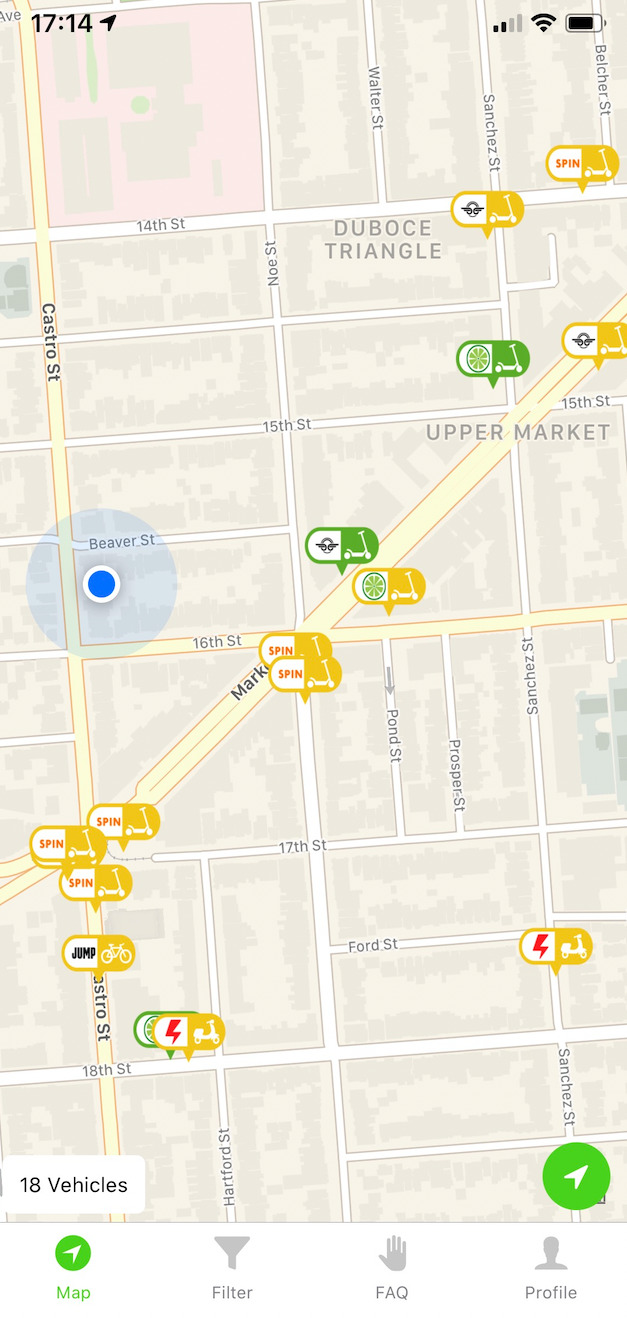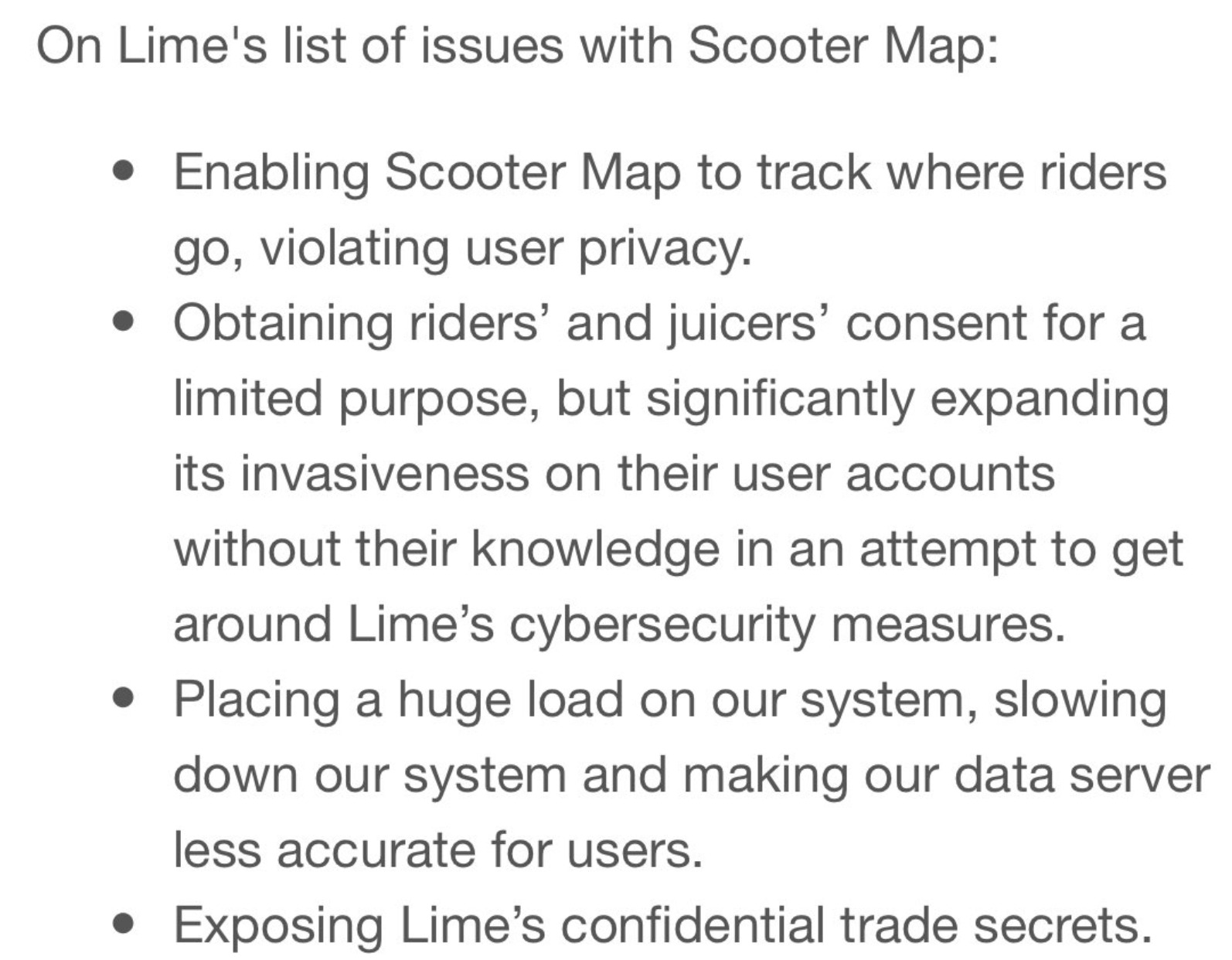If you’re a Lime juicer and Scooter Map-user, you’ll want to read this story! Is Lime picking on Scooter Map in order to shut it down – or is there something more going on behind the scenes? RSG contributor Chonce Maddox Rhea breaks down what’s going on with the back-and-forth between Scooter Map and Lime.
If you’ve taken up Lime juicing to earn extra money by pulling Lime scooters off the street and charging them overnight, you know that this work can be pretty challenging.
It takes time to locate and retrieve scooters along with trying to find space in your car to transport everything and room in your home to complete the charging.
Apps like Scooter Map can make your job a lot easier by helping you locate scooters in your area and filtering them to ensure that a scooter will be available when you get there. Thus, using Scooter Map can help you make more $$ – similar to aggregator apps like Mystro for Uber and Lyft drivers.
Despite this, Lime, one of the companies Scooter Map aggregrates, has threatened to sue Scooter Map company and asked Apple to get rid of the app.
Scooter Map’s founder Victor Pontis called Lime’s action ‘bullying at it’s finest’ and encouraged others to sign a petition to fight back against the claims. Read on though and we’ll let you decide if Scooter Map is in the wrong or if this is just another case of big company bullying.
Lime vs. Scooter Map: The Main Differences
From the outside looking in, it would seem as if Lime and Scooter Map have some similarities but are still two different companies with two different objectives.
Lime is an electric scooter rental company that allows you to find an available scooter near you, unlock it for use, then ride to your destination all through one app. Lime’s app allows you to scan the QR code located on the handlebars to unlock the device and pay for your ride.
Electric scooters have been growing in popularity and expanding to several different markets in recent years, so it only makes sense that gig work has also been established. Scooters need to be charged overnight then put back out on the street during the day time for use. You or someone you know may already be earning extra money by charging scooters, and that’s where apps like Scooter Map come in handy.
While you can use the Lime app to locate where scooters are available, Scooter Map takes a more in-depth approach to finding scooters in your area more efficiently so you can charge them and earn more cash.
Scooter Map launched in 2019 and helps you find scooters from multiple companies including:
- Bird
- Lime
- Voi
- Spin
- Jump
- Lyft
- Skip
- Scoot
- Razor

With this app, you can filter your scooter search by categories like: last seen, last GPS, company, battery, and more to ensure that scooters will actually be available when you arrive. Scooter Map is not just for scooter chargers – scooter riders can benefit from using the app as well. Another huge perk is that you can unlock multiple different scooter types all from one app.
Lime’s Reasoning to Shun the App
Lime’s reasoning behind their petition was revealed in a statement that claimed: “Scooter Map’s approach negatively impacts the rider experience and trust we’ve built with our users which is why we have asked them to stop scraping our API in violation of the law and our terms of service.”
The company went on to further explain their issues with Scooter Map in the statement.

Their statement continued to add: “To avoid detection, Scooter Map continues to use riders’ and juicers’ accounts — well after they’ve stopped using Scooter Map — to ping Lime’s servers sometimes over a thousand times in a single hour, placing a huge load on our system and making our data server less accurate for users.”
Taylor Bennet, a spokesperson for Lime that I spoke with, indicated that the company had tried to communicate with the app’s founder several times and sent an original cease and desist last spring then another one as recently as this past October.
“Lime is not opposed to partnering with other parties to display available scooters; in fact, we’re already integrated with Uber and Google Maps and are working on some integrations now with public transport so that cities can display our scooters. But Scooter Map is not an approved partner,” Taylor added.
How Scooter Map Responded
Scooter Maps founder and developer, Victor Pontis, fired back on Twitter by breaking down these claims and defending the app.
Privacy – huh? Scooter Map can track people who have the app open, like every other app. But we don’t share user data
2 – just false
3 – you’d think Lime’s CTO would have mentioned this to me in person
4 – maybe Lime is mad because @SpringMobility biz beat Lime for permits pic.twitter.com/mFMqauYjYa
— Victor (@VictorPontis) January 20, 2020
I started Scooter Map to make it easy to find scooters and bikes.
First, I focused on helping gig-worker chargers make more money each hour. Later, I expanded the rider side.
Lime, apparently, doesn’t like Scooter Map because Lime wants to be the only scooter company you use.
— Victor (@VictorPontis) January 16, 2020
On Twitter, he went on to share that Scooter Map is a small start-up that he’s running by himself at the moment and it’s barely breaking even. His tweets also accuse Lime of wanting to monopolize the industry while stating Lime claims to value partnership but continues to bully smaller companies like his.
He responded to Lime stating that they reached out to him beforehand by saying: “They haven’t sincerely reached out. They’ve sent threats. I personally know many people at Lime including the CTO but when I reached out to them, the legal team told me I wasn’t allowed to chat with them.”
My Take
From a consumer’s standpoint, I can see how apps like Scooter Map can be extremely helpful. My first scooter experience was actually this past September when I went to Washington D.C. for a work trip.
I live in Illinois, where using scooters has taken a longer time to get established, so I saw D.C. as the perfect opportunity to get my first Lime, Bird ride, or simply a ride on whatever electric scooter I could find.
I’ll admit, it was difficult to find and actually unlock a scooter, and I found myself frantically trying to download multiple different scooter apps, connect my payment, and run to certain locations on the map all as my phone was dying – I’m definitely investing in a battery pack for my next trip so I learned my lesson there.
I actually wish I’d known about an app like Scooter Map that combined all the available scooter options to me as it could have saved me a lot of time and stress that day. It’s a common fact that most apps track your location while you’re logged in, so I personally have no problem there. The problem for me lies when an app continues tracking my location or using my data after it’s been closed. But it doesn’t seem like Scooter Map does that.
I can also appreciate Scooter Map’s resources and other aid for electric scooter chargers looking to make extra money. So in my opinion, Scooter Map fills in the gap here.
What Can You Do?
I’m not going to tell you who’s side to take in this situation as it may even be too early to determine this. Personally, I don’t like it when big companies tend to pick on the up-and-coming ‘little guy’.
Ultimately, it would be great if both companies could have an open and honest conversation and compromise to resolve this issue.
Scooter Map was specifically designed to help gig workers make more money and riders find the nearest scooter or bike. Scooter Map also supports gig workers by offering helpful tips and guides to aid them in becoming a successful charger for multiple companies and make $30 per hour.
If you’ve used the app before and want to support it, Victor has a petition here and you can also retweet his thread on Twitter.
Readers, what do you think of this Lime vs Scooter Map debate?
-Chonce @ RSG




